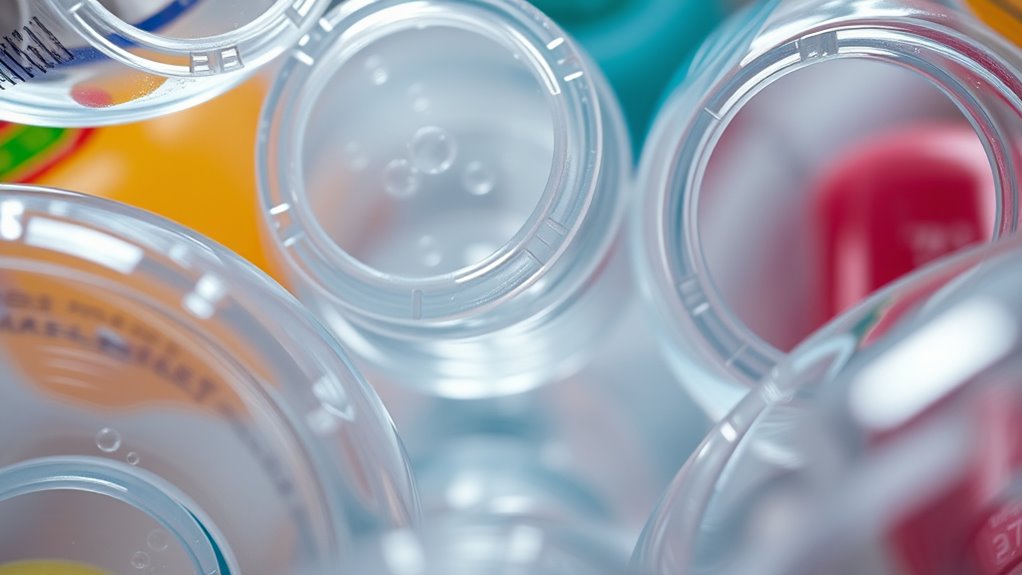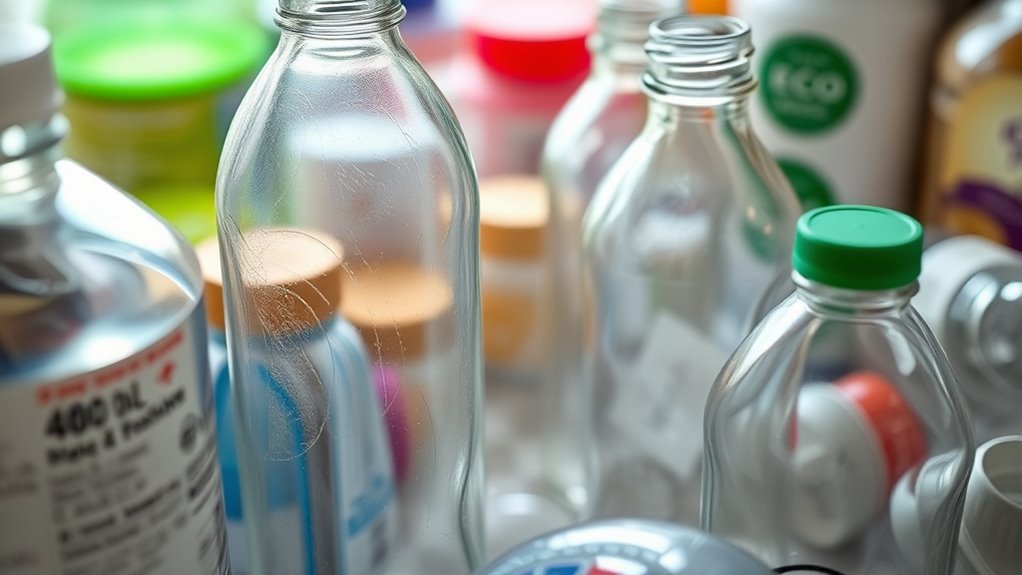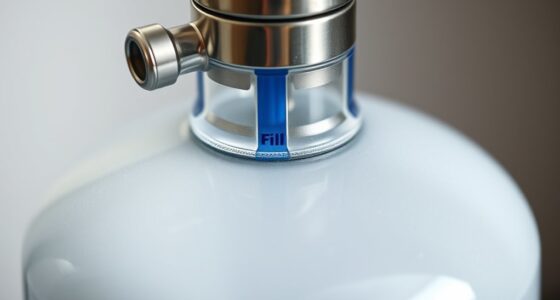To avoid chemicals like BPA, BPS, and phthalates, look for products labeled “BPA-free” and check their materials; options include glass, stainless steel, or BPA-free plastics such as polyethylene and polypropylene. Steer clear of plastics marked with recycling codes 3, 7, or those containing added plasticizers. Staying informed about safe material choices can help protect your health, and exploring more about safer options will give you a clearer path forward.
Key Takeaways
- Opt for BPA-free plastics made from polyethylene or polypropylene, avoiding PVC (3), PC (7), and plastics with added plasticizers.
- Consider alternatives like glass, stainless steel, silicone, bamboo, or recycled materials for safer, non-toxic options.
- Always check product labels and safety data sheets to verify chemical composition and safety claims.
- Stay informed on current regulations and industry standards to select materials that meet safety and environmental guidelines.
- Prioritize sustainable choices that reduce chemical exposure and environmental impact, supporting long-term health and safety.

Are you choosing the right materials for your project? It’s a vital step that can impact not only the quality of your work but also the safety of those who will use or interact with it. When evaluating materials, chemical safety should be at the top of your list. Many plastics and resins contain chemicals like BPA (bisphenol A), BPS (bisphenol S), and phthalates, which have raised concerns due to their potential health effects. These substances are often used to make plastics more flexible or durable, but studies link them to hormonal disruptions, reproductive issues, and other health problems. Recognizing these risks, it’s essential to look into alternative materials that offer the same functionality without compromising safety.
In your search for safer options, consider materials that are free from BPA, BPS, and phthalates. Many manufacturers now produce plastics labeled as “BPA-free,” but it’s wise to verify claims and research the composition of products you’re considering. Some alternative materials include glass, stainless steel, and certain BPA-free plastics made from polyethylene or polypropylene, which are generally regarded as safer choices for food contact or consumer products. When prioritizing chemical safety, avoid plastics with recycling codes 3 (PVC), 7 (other), or those containing added plasticizers, as these are more likely to contain phthalates or other harmful chemicals. Additionally, being aware of regulatory frameworks can help you better understand industry standards and safety assessments.
Choosing alternative materials isn’t just about safety; it also involves considering environmental impact and sustainability. Materials like silicone, bamboo, or recycled plastics can serve as eco-friendlier options, reducing reliance on chemicals linked to health concerns. Keep in mind that some alternative materials might have different durability or cost implications, but investing in safer, non-toxic options can save you from future health or disposal issues.
Incorporating the right materials from the start can streamline your project and prevent costly modifications later. Always review product labels, consult safety data sheets, and stay informed about the latest research on chemical safety. While it might seem overwhelming at first, making well-informed choices about the materials you use demonstrates your commitment to health, safety, and environmental responsibility. Ultimately, selecting safer, alternative materials aligns with best practices and ensures your project remains both effective and safe for everyone involved.
Frequently Asked Questions
Are BPA, BPS, and Phthalates Safe During Pregnancy?
During pregnancy, BPA, BPS, and phthalates are not considered safe due to potential risks to your baby’s development. You should prioritize chemical safety by avoiding plastics and products that contain these substances. Stay informed through consumer awareness, reading labels carefully, and choosing BPA-free or phthalate-free options. Protect your health and your baby’s by making conscious choices and reducing exposure to harmful chemicals during this essential time.
How Can I Identify Products Containing These Chemicals?
You can identify products containing these chemicals by checking the product labeling for specific terms like BPA, BPS, or phthalates. Look for labels that mention “BPA-free” or “phthalate-free” to make safer choices. Additionally, if you’re unsure, consider chemical testing services that analyze products for these substances. Always read labels carefully and opt for products from reputable brands committed to avoiding harmful chemicals.
Do These Materials Leach Into Food and Drinks?
These chemicals can definitely migrate into your food and drinks, and it’s more common than you might think! Chemical migration occurs when substances like BPA, BPS, and phthalates seep from containers into what you consume. Testing methods such as chemical analysis and migration testing help identify this. To stay safe, use glass or stainless steel containers, and always check product labels for potential chemical presence.
Are There Natural Alternatives to BPA, BPS, and Phthalates?
Yes, there are natural substitutes and plant-based plastics you can consider. You might choose containers made from bioplastics like PLA (polylactic acid) or those derived from renewable resources such as cornstarch or sugarcane. These plant-based plastics are often free from harmful chemicals like BPA, BPS, and phthalates, making them safer options. Always check product labels to verify they’re made from natural alternatives and suitable for food contact.
What Regulations Exist to Limit Exposure to These Chemicals?
Regulation standards, chemical labeling, and bans aim to limit your exposure to these harmful chemicals. Agencies like the FDA and EPA set safety thresholds, requiring clear labeling so you can make informed choices. Some states have restricted certain uses, while manufacturers are pressured to replace these chemicals with safer alternatives. Stay vigilant by reading labels and supporting regulations that prioritize your health and reduce your risk of exposure.
Conclusion
As you navigate the world of everyday materials, remember that not all plastics and chemicals are harmless. BPA, BPS, and phthalates lurk silently, hiding in places you least expect. Will you choose to ignore the potential risks, or will you take action to protect yourself and loved ones? The choice is yours, but the stakes are higher than you think. Stay vigilant—what you don’t see could impact your health in ways you can’t yet imagine.
Cindy thoroughly researches juicing trends, techniques, and recipes to provide readers with practical advice and inspiration. Her writing style is accessible, engaging, and designed to make complex concepts easy to understand. Cindy’s dedication to promoting the advantages of juicing shines through her work, empowering readers to make positive changes in their lives through the simple act of juicing.











